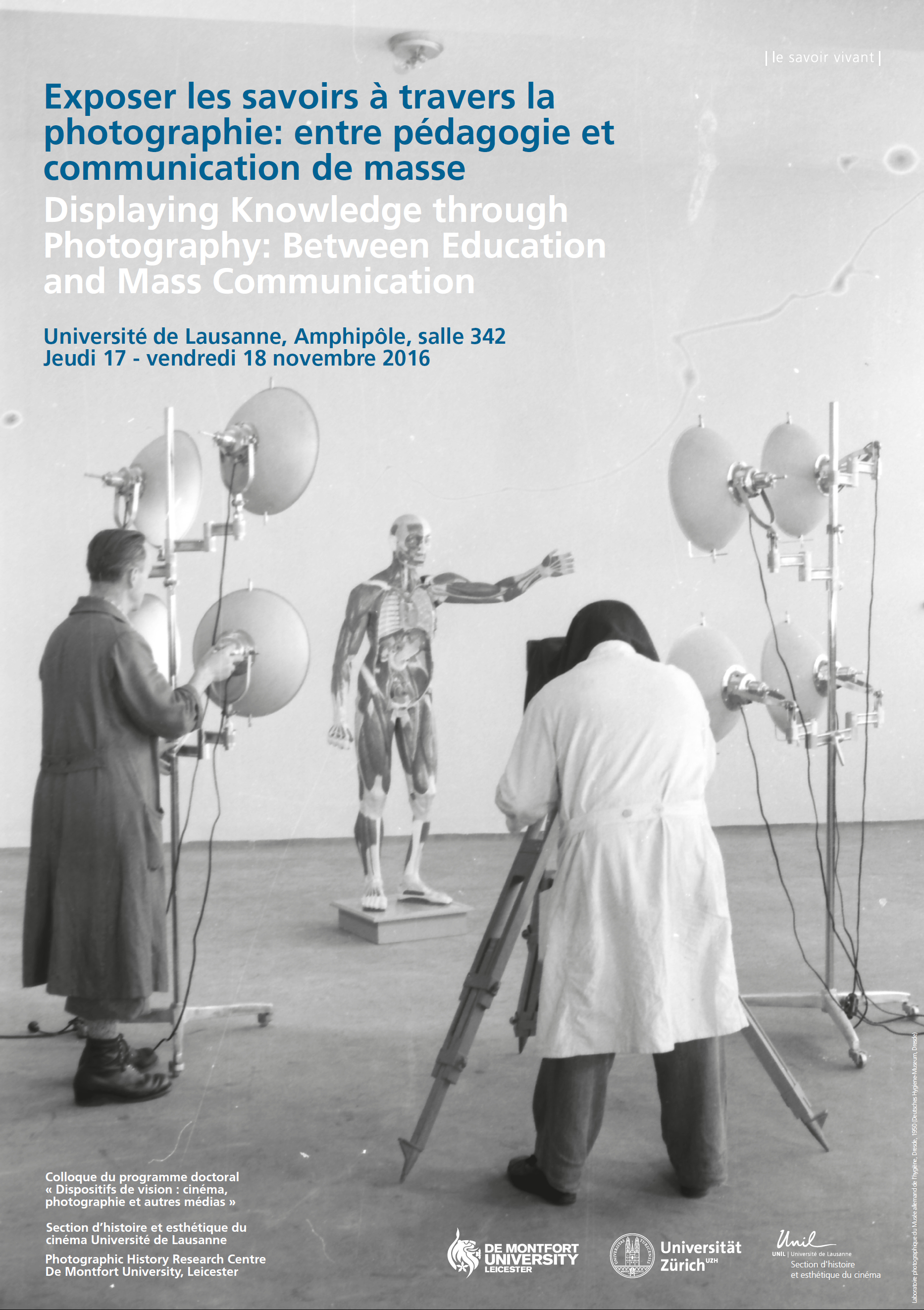EXPOSER LES SAVOIRS A TRAVERS LA PHOTOGRAPHIE
ENTRE PEDAGOGIE ET COMMUNICATION DE MASSE
DISPLAYING KNOWLEDGE THROUGH PHOTOGRAPHY
BETWEEN EDUCATION AND MASS COMUNICATION
Sous la direction d'Olivier Lugon
En partenariat avec Kelley Wilder (De Montfort University, Leicester)
Photographic History Research Centre
Au moment où elle apparaît, la photographie semble moins porter la promesse d’un nouveau moyen d’expression ou de création que celle d’un nouveau support des savoirs, contribuant aussi bien à construire les connaissances qu’à les faire circuler. Elle participe à un phénomène plus large de popularisation des sciences et de démocratisation des savoirs, dont les canaux iront en se diversifiant au cours des décennies. Sa qualité indicielle constitue ici son principal atout, abondamment discuté depuis, de même que sa capacité à être archivée en masse et à mettre à disposition sous forme graphique tous les objets du monde. D’autres aspects cependant, moins liés au mode de production que de circulation et de présentation de l’image photographique vont tout autant compter. C’est ainsi que sa faculté à prendre des formes matérielles multiples vont lui permettre d’être intégrée à des canaux très divers de communication des idées et des connaissances – les livres, les albums, les expositions, les conférences, les projections – et à envahir des espaces publics variés – musées, bibliothèques, salles de classe et autres espaces urbains. Ce n’est dès lors pas tant l’image photographique en soi qui déploie un potentiel pédagogique inédit que la façon dont elle vient s’inscrire dans des cadres visuels, discursifs, matériels et institutionnels toujours renouvelés.
When it first appeared, photography seemed to profess rather less the promise of a new medium of expression or creation than it did a new knowledge platform, contributing as much to the construction of knowledge as to its circulation. Photography is then part of a larger phenomenon of scientific popularisation and democratisation of knowledge, the channels of which will diversify throughout the following decades. Its indexical quality constitutes one of its prime assets – widely discussed since then –, alongside the medium’s capacity to be archived in great numbers and present every object of the world at the viewer’s disposal in graphic form. However, other aspects, less linked to modes of production than to the circulation and presentation of the photographic image, count just as much. Photography’s capacity to take multiple material forms allow it to be integrated into a number of channels of communication of knowledge and ideas – books, albums, exhibitions, conferences, projections – and to occupy a plurality of spaces – museums, libraries, classrooms, outdoor urban spaces, etc. It is therefore not the photographic image as such that deployed novel educational potential, but rather the way the medium is inscribed in ever changing visual, discursive, material and institutional frames.
Le présent colloque se propose de revenir sur les usages éducatifs variés de la photographie du XIXe au XXIe siècle, que ce soit pour diffuser des connaissances scientifiques ou historiques, des informations économiques, des doctrines politiques, et que cela prenne la forme de publications, d’expositions, de conférences, de diaporamas, de films ou de sites web. Quels nouveaux canaux de diffusion et de démocratisation des savoirs ont émergé avec la photographie et comment ceux-ci ont transformé les modes de communication du monde savant ? Quels acteurs ont été impliqués dans ce processus de médiatisation – scientifiques, photographes, éditeurs, bibliothécaires, commissaires ou graphistes – et comment ont-ils interagi ? Comment les formes traditionnelles de visualisation du savoir scientifique et de la communication pédagogique (atlas, cartes, tableaux, albums) ont rencontré les nouveaux modèles issus du photomontage, du design graphique, du montage cinématographique ou de la scénographie d’exposition ? De quelle façon le dogme de l’objectivité a-t-il été adapté aux nouvelles techniques de persuasion issues de la presse illustrée, de la publicité ou de la propagande ? De façon générale, comment a-t-on pu articuler l’affirmation d’une prétendue langue « naturelle » et « universelle » de la photographie et sa nécessaire inscription dans des systèmes visuels et discursifs qui ne cessent de la médiatiser ?
This conference proposes to reflect upon the varied didactic uses of photography in the 19th to 21st century, be it to share scientific, historical, economical, or political knowledge in the form of publications, exhibitions, conferences, slide shows, films or websites. What new channels of dissemination and democratisation of knowledge have emerged with photography and how did these transform scholarly modes of communication? Which actors were implicated in the process of mediatisation – scientists, photographers, editors, librarians, curators or graphic designers – and how did they interact? How did traditional forms of visualisation of scientific knowledge and pedagogical communication (atlases, maps, charts, albums) encounter the new models issued by photomontage, graphic design, film editing or exhibition design? How did the dogma of objectivity adapt to new techniques of persuasion issued from illustrated press, advertising or propaganda? Generally speaking, how was the claim of the so-called “natural” and “universal” language of photography articulated in relation to its necessary inscription in visual and discursive systems that have incessantly mediatised it?

Brochure bilingue du colloque (1187 Ko)

